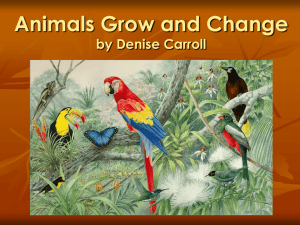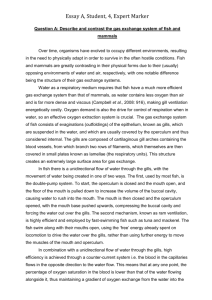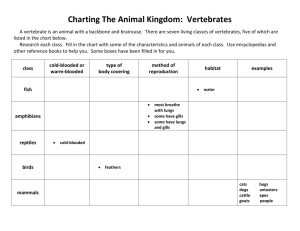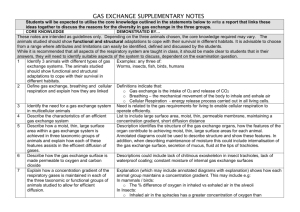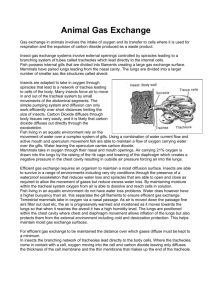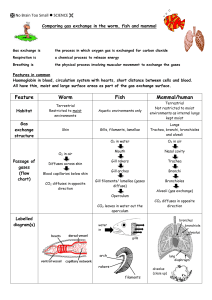gas exchange in animals
advertisement
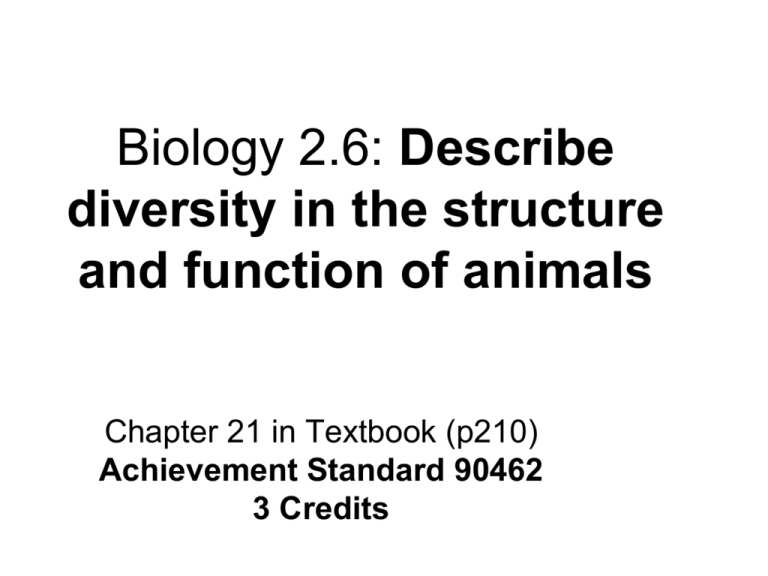
Biology 2.6: Describe diversity in the structure and function of animals Chapter 21 in Textbook (p210) Achievement Standard 90462 3 Credits ANIMAL Diversity 1 Learning Intention: Identify 3 animals with different types of gas exchange systems. Define gas exchange, breathing and cellular respiration and explain how they are linked SUCCESS CRITERIA: Can Identify 3 animals with different types of gas exchange systems. Can Define gas exchange, breathing and cellular respiration and explain how they are linked What is Diversity? http://www.youtube.com/watch?v=jLuK-EBkcww • • • • Diversity: [dih-vur-si-tee] noun, plural 1. the state or fact of being diverse; difference; unlikeness. • 2. variety; 3 animals • For each of the animals pictured below, describe their habitat and their structural, physical and behavioral features • Is there a relationship between their features / adaptations and their habitat? Discuss. http://www.youtube.com/watch?v=7798h1s iNO8 Terminology • 73774728466 • 427 39242643 • 273284464 Term My Definition Biological Definition The difference between the two Gas Exchange • “The movement of gases across a membrane” Why do we need to carry out gas exchange? Figure 10.8A Breathing Animation ANIMAL Diversity 2 Learning Intention: Identify the need for a gas exchange system in multicellular animals Describe the characteristics of an efficient gas exchange system SUCCESS CRITERIA: States the need for a gas exchange system States the characteristics of an efficient gas exchange sys GAS EXCHANGE IN ANIMALS We will be studying the diversity of adaptations for this process in THREE animal groups: Fish Mammals Insects GAS EXCHANGE SURFACES Gases move by diffusion. Diffusion is greater when: • the surface area is large • the distance travelled is small • the concentration gradient is high Gas exchange also requires a moist surface • O2 and CO2 must be dissolved in water to diffuse across a membrane GAS EXCHANGE SURFACES To maximise diffusion, an efficient gas exchange surface will… 1. have a large surface area 2. provide a small distance for gases to diffuse across 3. be moist 4. Maintain a favourable concentration gradient for the diffusion of both gases. STRUCTURE OF THE GAS EXCHANGE SURFACE Depends on: • the size of the organism • where it lives – water or land • the metabolic demands of the organism – high, moderate or low DIVERSITY IS REQUIRED!!!! Need for a gas exchange system in multicellular animals PROBLEM • the distance a gas can diffuse is only millimeters • This means single celled and very small organisms can easily exchange gases over their membranes as they have a large surface area compared to their volume • But why cant multicellular organisms? As multi-cellular organisms get larger, more and more cells will not be in direct contact with the air or will not be near enough to the surface to receive oxygen and expel carbon dioxide through direct diffusion. They have a low surface area: volume ratio They therefore need a gas exchange system Conclusions: • As an organism becomes larger, their volume increases at a faster rate than their surface area. Problems? Only inactive organisms could be supported • Solutions? Flattened shape OR surfaces It would take too long to reach the middle of the organism Specialised exchange multicellular animals need a gas exchange system An exception: • Many multicellular animals are small enough that they don't require a specialized gas exchange system • Flatworms (phylum Platyhelminthes) have adaptations that eliminate the need for a complex respiratory (and circulatory) system. • Platyhelminthes are flattened— "flatworms." This flattening makes them very thin and gives them a large ratio of surface area to volume. • The flatworm's respiratory surface area is large enough to service its relatively low volume. Task 1. Do WB p 191, 192 2. Exam Q: • Multicellular animals are large and have made certain adaptations to ensure their oxygen requirements are met. Explain why they have made these adaptations and the common features of the adaptations ANIMAL Diversity 3 Learning Intention: Describe how a moist, thin, large surface area within a gas exchange system is achieved in Insects SUCCESS CRITERIA: Label parts of an insects anatomy Explain gas exchange in insects Gas Exchange in Insects • Take your photocopy, and make notes as we move through the process of gas exchange for insects • The respiratory system of insects (and many other arthropods) is separate from the circulatory system. It is a complex network of tubes (called a tracheal system) that delivers oxygen-containing air to every cell of the body. • Air enters the insect's body through valve-like openings in the exoskeleton. • These openings (called spiracles) are located along the thorax and abdomen of most insects -- usually one pair of spiracles per body segment. • Air flow is regulated by small muscles within each spiracle • After passing through a spiracle, air enters a longitudinal tracheal trunk • It diffuses throughout a branching network of tracheal tubes that subdivide into smaller and smaller diameters and reaches every part of the body. • At the end of each tracheal branch, a special cell (the tracheole) provides a thin, moist surface for the exchange of gasses • Oxygen is dissolved in liquid at the tracheole and then diffuses into the cytoplasm of an adjacent cell. • At the same time, carbon dioxide diffuses out of the cell and, eventually, out of the body through the tracheal system. Tracheoles Spiracle Trachea Task • WB page 196 ANIMAL Diversity 4 Learning Intention: Describe how a moist, thin, large surface area within a gas exchange system is achieved in mammals SUCCESS CRITERIA: Label parts of a mammal anatomy Explain gas exchange in mammals DO NOW: Draw an insect and label parts of its respiratory system Human Respiratory System Figure 10.1 Four Respiration Processes Breathing (ventilation): air in to and out of lungs. 2 parts – Inspiration (breathing in) and Expiration (breathing out) External respiration: gas exchange between air and blood Internal respiration: gas exchange between blood and tissues Cellular respiration: oxygen use to produce ATP, carbon dioxide as waste Components of the Lower Respiratory Tract Figure 10.3 MAMMAL LUNGS: BREATHING Two lungs ventilated by movement of diaphragm and ribs MAMMAL LUNGS: STRUCTURE Rubber cast of human lungs MAMMAL LUNGS: STRUCTURE System of tubes (held open by rings of cartilage) allow air to flow in and out of lungs • Air enters via trachea (windpipe) • Trachea branches into two bronchi (one bronchus to each lung) • Bronchi branch into bronchioles MAMMAL LUNGS: STRUCTURE Many alveoli at the end of the bronchioles • walls made of flat cells; only one cell thick • each alveolus lined with moisture • surrounded by capillary network carrying blood GAS EXCHANGE IN MAMMALS Gas exchange animation ENHANCING THE EFFICIENCY OF MAMMAL LUNGS Large surface area • many tiny alveoli • area as big as a tennis court in humans! Short distance for diffusion • alveoli and capillary walls only one cell thick • capillaries pressed against alveoli Moist • wet lining of alveolus • system internal to reduce water loss by evaporation Maintaining a concentration gradient • air (with depleted O2 and excess CO2) is exhaled replaced with fresh inhaled air • blood (having lost CO2 and been enriched with O2) returns to heart to get pumped around body Task • WB p 197-199 • http://bcs.whfreeman.com/thelifewire/conte nt/chp48/4802002.html ANIMAL Diversity 5 Learning Intention: Describe how a moist, thin, large surface area within a gas exchange system is achieved in fish SUCCESS CRITERIA: Label parts of a fish anatomy Explain gas exchange in fish DO NOW: Draw a mammals respiratory Structures (include lungs AND close up of alveoli). Use red and blue to show Blood oxygenation http://newswatch.nationalgeographic .com/2011/06/16/weird-wildspongebob-mushroom-named/ Blood https://www.msu.edu/~kalinkat/professionalp ages/TechMatrixMaterials/documentarybloo dmisconceptions.htm Hodgson: incorrect Michigan State Uni: correct Anatomy External GETTING OXYGEN FROM WATER: FISH GILLS • Each gill made of four bony gill arches. • Gill arches lined with hundreds of gill filaments that are very thin and flat. GETTING OXYGEN FROM WATER: FISH GILLS • Gill filaments are have folds called lamellae that contain a network of capillaries. • Blood flows through the blood capillaries in the opposite direction to the flow of water. Each gill arch has many filaments Each filament has many lamellae RADAR TIME • Using your Radar, colour in how developed your knowledge is of the anatomy of the fish gill. • If you colour: – 1/3: Trace and label the structure from TB p212 on a new piece of paper – 2/3 : Do p193 in WB – 3/3: put your hand up OSMOSIS INTERNAL You have 10 min. ? = more info required X = incorrect * = does not make sense CV = control variable identified General comment: Make sure you identify the correct Independent, Dependent and Control variables before moving on ANIMAL Diversity 6 Learning Intention: Describe how a moist, thin, large surface area within a gas exchange system is achieved in fish SUCCESS CRITERIA: Explain gas exchange in fish DO NOW: Draw a mammals respiratory Structures (include lungs AND close up of alveoli). Use red and blue to show Blood oxygenation GETTING OXYGEN FROM WATER: FISH GILLS • Gills covered by an operculum (flap) • Fish ventilates gills by alternately opening and closing mouth and operculum water flows into mouth over the gills out under the operculum • Water difficult to ventilate gills near surface of body WATER AS A GAS EXCHANGE MEDIUM No problem in keeping the cell membranes of the gas exchange surface moist BUT O2 concentrations in water are low, especially in warmer and/or saltier water SO the gas exchange system must be very efficient to get enough oxygen for respiration ENHANCING THE EFFICIENCY OF FISH GILLS • Gills have a very large surface area: four arches with flat filaments with lamellae folds • Gills are thin-walled and in close contact with water: short distance for diffusion • Gills have a very high blood supply to bring CO2 and carry away O2 dark red colour • Gills are moist: fish live in water! ENHANCING THE EFFICIENCY OF FISH GILLS Fresh water flows over gills in one direction. COUNTER-CURRENT FLOW: water and blood in the gills flow in opposite directions maintains a favourable concentration gradient for diffusion of both gases Concurrent flow animation Countercurrent flow animation CONCURRENT FLOW COUNTER-CURRENT FLOW Task Radar • 1/3 – come sit in front bench • 2/3- continue with TB p194 as a group, utilizing answer booklet • 3/3 – worksheet ANIMAL Diversity 7 and 8 Learning Intention: Compare and contrast how efficient gas exchange is maintained in 3 animal groups SUCCESS CRITERIA: Explain how efficient gas exchange is maintained in 3 animal groups DO NOW: Draw a fish’s respiratory Structures. Use red and blue to show Blood oxygenation Insects Mammals Fish Explain how the concentration gradient is maintained Explain how the diffusion distance is minimised Explain how the gas exchange surface is kept moist Explain how a large gas exchange surface area is provided Remember – annotated diagrams tell 1000 words! You have the double period to complete this to Excellence standard. Use your notes, books, and the PWP is available to use GETTING OXYGEN FROM AIR: MAMMALS, BIRDS & INSECTS As a gas exchange medium, air has many advantages over water: • Air has a much higher oxygen concentration than water • Diffusion occurs more quickly so less ventilation of the surface is needed • Less energy is needed to move air through the respiratory system than water GETTING OXYGEN FROM AIR: MAMMALS, BIRDS & INSECTS BUT as the gas exchange surface must be moist, in terrestrial animals water is continuously lost from the gas exchange surface by evaporation SO the gas exchange surface is folded into the body to reduce water loss. WARM-BLOODED ANIMALS Warmth speeds up body’s reactions enables faster movement etc BUT increases evaporation of water from lungs AND increases demand for energy to stay warm SO higher demand for gas exchange to provide O2 for and remove CO2 from respiration ANIMAL Diversity 9 Essay scaffolding ANIMAL Diversity 10 Learning Intention: Compare and contrast colours of gas exchange surfaces SUCCESS CRITERIA: Explain similarities and differences in colours of gas exchange surfaces DO NOW: • Draw fish, mammal and insect respiratory structures. • Label and use red/blue to show oxygentaed and deoxygenated blood Compare and contrast • Colour. Why? Unit Standard 8925 • Wed – P6 – Lung Dissection (40min) (element 1) • Thursday – P3 – Gill dissection (element 1) – P4 – Write-up Element 1 and Element 2 Element 1 – Dissections - Task 1 - drawing and labeling structures - Task 2 - Write-up: 3 questions based on the structures. Element 2 – Unit Standard test - Task 1: how animal group achieves efficient gas exchange - Task 2: How gas exchange systems are related to the animals way of life How many filaments? • You will have to work out how many filaments a fish has in your Unit Standard How will you do it? Step 1: count the number of filaments in a cm piece of gill arch Step 2: ….
